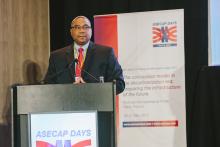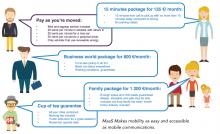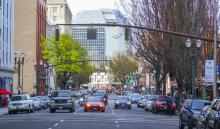
Geoff Hadwick attended ASECAP’s 2015 Study Days meeting in Lisbon and found a frustrated European tolling sector undertaking some soul searching.
The international road tolling industry its failing to make it case and the sector is losing out to a range of other socio-political lobby groups according to International Bridge, Tunnel and Turnpike Association (
From his position as the leader of the Washington-based association, Jones said “we may well have a political and business environment that is friendly towards tolling, but have we really made any progress in recent years? Yes … some. But not enough. Tolling is still on the sidelines.”
Looking at other lobby groups such as the gay and lesbian movement, which has campaigned successfully for the modern acceptance of same-sex marriages, Jones asked the
It’s time to shout louder was his rallying call. The tolling industry must come together with a much more persuasive message, and find new ways to force the politicians into doing something. Kallistratos Dionelis general secretary of Brussels-based ASECAP, the professional association for the operators of tolled motorways, bridges and tunnels, agreed. He told ITS International: “We need to say to the European Commission that it is time to stop dreaming. We need action, and we need it now.”
Dionelis spoke for virtually all of the presenters at the association’s 43rd annual study and information days meeting when he added: “It’s all very well having a vision, but if all you ever do is have visions you need to go and see an eye doctor.” He wants an EU-wide “consistent,” properly enforced and inter-operable tolling scheme put into place as soon as possible.
As the general secretary he is feeling increasingly frustrated. Even though “Europe is slower” because it lacks the centralised federal government that runs everything in the USA, Dionelis cannot accept just how poor the EU decision-making process is.
The “European political landscape” may well be “diverse and fractured,” he conceded, but there is a deepening sense of unease over the tolling industry’s track record in getting Europe’s politicians to take action and push forward new schemes. Something needs to change.
ASECAP president, Norwegian politician Øyvind Halleraker, agreed. “We will ask the politicians to build a strong relationship with the road industry. We need to interact, to plan, to help finance and operate the European road network and create reliable and smooth traffic flows. It is very important. We have the citizens and users of Europe at heart. We want smart roads, vehicles and drivers. We want a well informed and comfortable driver, not an over-informed one.”
Consensus on initiatives like these are needed. Somehow or other the EU tolling industry needs to find a louder voice and a compelling case for enabling legislation and the money to make it happen. The sector needs to avoid what Pat Jones described as a “disturbing funding crisis” in the USA. “The US trust fund for highways is now in precipitous decline,” he told the conference. “US tax payers don’t want to pay any more money and we now face a negative balance of US $120 billion by 2024.”
Why are things so bad in the States? “Because 1993 was the last time the US authorities increased the Federal Gas Tax,” said Jones, and no new nationwide initiatives (such as electronic road charging) are being taken to replace the lost revenue in real terms.
Europe needs to face the facts said Czako. A good quality highways system is fundamental to economic growth and national prosperity. “Passenger and freight [movements] have increased constantly since 1990” across the EU, he told the conference. “Inland goods transport is plus 75% over the same period and passenger inland transport is plus 80%.” And yet, Europe’s “infrastructure is ageing and the budgets for road infrastructure are constantly decreasing [in terms of new investment and maintenance].
Even so, GDP is constantly climbing.” Act now or see the EU’s roads grind to a halt he warned. “The socio-economic cost of congestion is continuously climbing. In Europe, the annual cost of congestion is €110billion (EC, 2012) and in the United States of America, congestion cost the economy about €95billion in lost output” according to a Texas A&M University report in 2011.
Unless something is done, “the result will be low sustainability and huge losses in GDP,” said Czako. “To increase sustainability and efficiency, appropriate financing of road transport infrastructure is needed. Congestion is climbing, and road capacity is limited. Therefore, the demand and capacity needs to be managed. Accident and fatality rates are unacceptably high and the external costs of traffic are only partly considered … including problems such as CO2, pollution, noise and accidents.”
All in all, mobility pricing is probably the best way forward he says. Why? Because mobility pricing “manages the demand and the road capacity; considers the real internal and external cost [noise, pollution, congestion, safety] of transport; strengthens the user pays principle in terms of relief tax financing [replacing declining fuel tax incomes]; is based on incentives rather than on prescriptions; fosters the change to a more sustainable attitude to road use; can be applicable for all roads and for all modes of transport (including city driving); generates revenues that can be dedicated mainly to improve sustainability ... and is fair.”
And then, as if to prove the point, Steve Morello, a senior partner with D’Artagnan Consulting gave the delegates an interesting case study on the “State of Oregon’s per mile road usage charge” scheme. It all began when the north-western coastal state adopted Senate Bill 810 which “directed Oregon’s Department of Transport (DOT) to implement a 1.5 cent per-mile road usage charge for 5,000 volunteer light vehicles as an operational test program from July 1, 2015.”
Is this a recipe for disaster? “Will Oregon’s Road Usage Charge Program be a government operated, single technology, closed system that will be expensive to operate and extremely difficult to change?” Morello asked. “No,” was the answer. “Oregon is establishing an open market billing platform for road usage charging.”
The strategic objective is to “create a sustainable road usage charge market that is simple and easy for payers, flexible and encourages evolution of mileage reporting technologies and business systems into effective, affordable, convenient and attractive options for the motoring public.”
The per mile charge system has been set up with clear guiding principles. These are, according to Morello, a “design program with open architecture.” It will run on a platform that will “provide motorists with choices that are technology agnostic.” The scheme will “provide access to private sector account management, be interoperable, scalable and geographically unlimited.” And, in summary, it will be completely “policy neutral.” Here is how it will work:
Oregon’s drivers will be treated like account holders interacting with any other normal commercial organisation. According to Morello, they will first “select a provider via the ODOT website or be recruited by a commercial account manager;” then they will “select their mileage reporting method as a basic or advanced user;” after which they will “receive an automatic fuel tax credit on their bill.” The next stage is to “activate their mileage reporting by installing an after-market device in vehicle or accessing telematics within the vehicle.” They are then free to drive.
Everything is laid out on the state’s website %$Linker:
Other states are following suit, Morello told the ASECAP delegates. Washington, California, Utah and Florida are all heading in the same direction. “We are right at the beginning of a dramatic shift in the way people pay to use the roads. We are starting a progressive policy that will replace fuel (gas) tax.” And, he added, it will only work if “private companies are involved.”
For Javier Rodriguez, IBTTA President, road and/or usage tolling is also the only way forward. “Tolling is the most powerful way to invest in and operate major highway networks,” he told the conference. Infrastructure improvement is essential if a country wants to help its businesses grow and things like fuel taxes are not the way to go ... electronic tolling please he said. “We don’t want toll booths everywhere.” The industry must work as hard as possible to get a positive reception from the policy-makers.
Alongside a wide-ranging discussion on Europe’s current position regarding EETS (European Electronic Toll Services) versus NETS (National Electronic Tolls Services), REETS (Regional European Electronic Toll Services) and EETS (European Electronic Toll Services) … and the difficulties in trying to get 28 sovereign states each with different national economies to come together, the ASECAP Study Days conference also took a look at some co-operative ITS (C-ITS) projects in Europe where a range of countries are coming together to work towards a common objective.
Torsten Geissler, chairman of the Amsterdam Group, gave an upbeat overview concluding that partnership working is more than possible. The C-ITS platform objective is to “develop a shared vision and a roadmap for the deployment of co-operative systems inside the EU,” he said. And the project is putting in place “building blocks for a communication by the European Commission on the deployment of C-ITS in 2016.” The Amsterdam Group is leading the way and is bringing together a range of agencies with joined-up thinking. It now comprises 13 OEMs and 24 global suppliers, 27 European road authorities, 16 ASECAP members, 5 associate members and police authorities from 58 different European cities and regions.
Each partner, according to Geissler, will help put together a “network of technical experts from the corridors to look issues such as: security; system specification profiling; a consistent legal framework; radio spectrums and frequencies; deployment and roll-out from day one; roadmaps beyond day one; conformance assessment; hybrid communication concepts; back-end services; user cases and applications.”
Guy Frémont from
Around 2,000km of roads have been equipped with road side units to monitor speed, traffic events, snow removal, bad weather conditions, low visibility, incidents, accidents, traffic jams, obstacles, animals and pedestrians. This information is then used for road hazard signalling, in-vehicle signage, safety messages, traffic information, road works warning, multimodal information, park and ride schemes and public transport activity.
Data is being collected by traffic / weather sensors, cameras, patrol vehicles, SOS telephones and GSM calls so that, according to Frémont, “vehicles are connected with the infrastructure and real-time information exchange between vehicles and the traffic operation centres” can take place. “Vehicles play the role of data and event sensors [floating car data],” he added, “receiving traffic information and warnings.” He sees no reason why the project could not be extended all over Europe. Once again, it is the politicians who need to make it happen.









